Abstract
The heavy chain (gamma-3) of the IgG3 subclass of human immunoglobulins has a molecular weight of 60,000, instead of the 50,000 value reported for gamma-1, gamma-2, and gamma-4 heavy chains. By use of protein Omm, a gamma-3 heavy chain disease protein, it was possible to isolate and analyze the extra fragment. Protein Omm had a molecular weight of 40,000, glycine as its sole NH-2-terminal, and contained only the hingee region and the C-H-2 and C-H-3 domains. CNBr cleavage at Met 252 (gamma-1 numbering) yielded the hinge fraction (Fh fragment). On the basis of the molecular weight of Fh (11,000), its amino-acid composition, its partial sequence, and its unexpectedly low number of tryptic peptides, it is postulated that the extra fragment in gamma-3 heavy chains represents a series of similar or identical duplications of sections of the previously reported gamma-3 hinge region. In addition, there are striking homologies with the hinge region of alpha-1 and alpha-2 heavy chains, one of which also has duplications. The relationship of these hinge structures in different immunoglobulins supports the concept that this region is coded by a unique, small piece of DNA, which has evolved in parallel manner with the immunogolbulin genes by partial duplications and/or crossingover.
Full text
PDF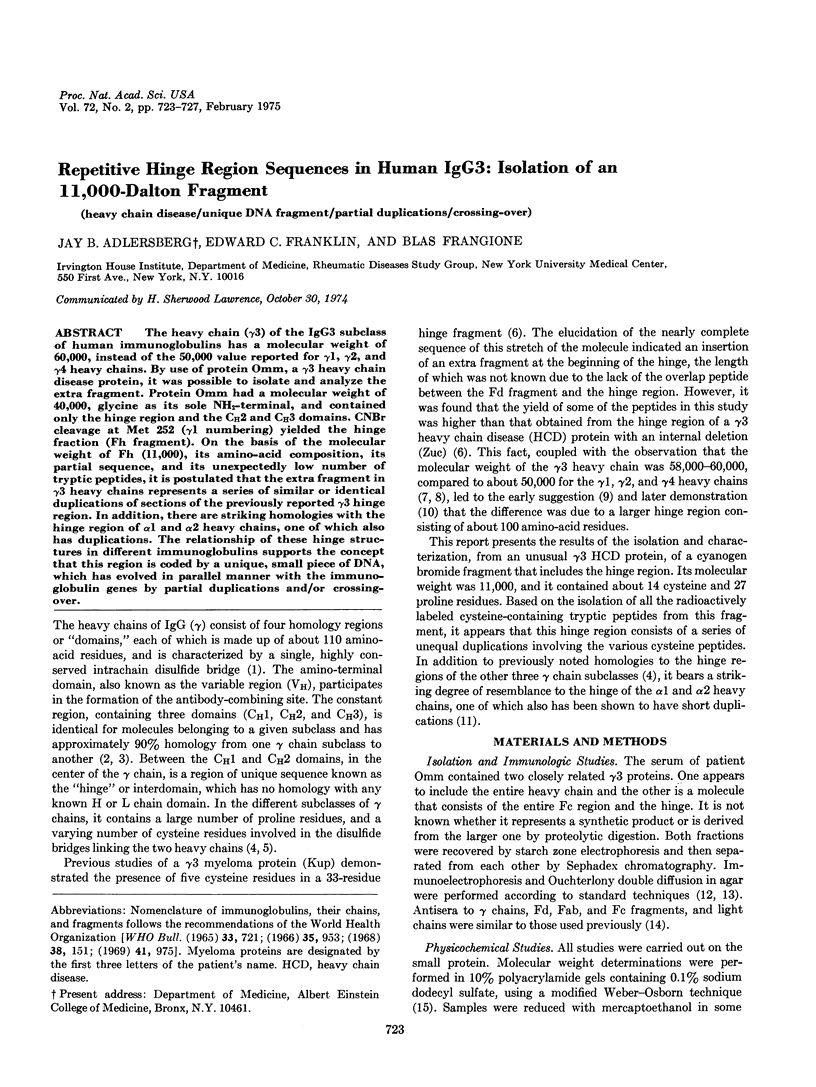
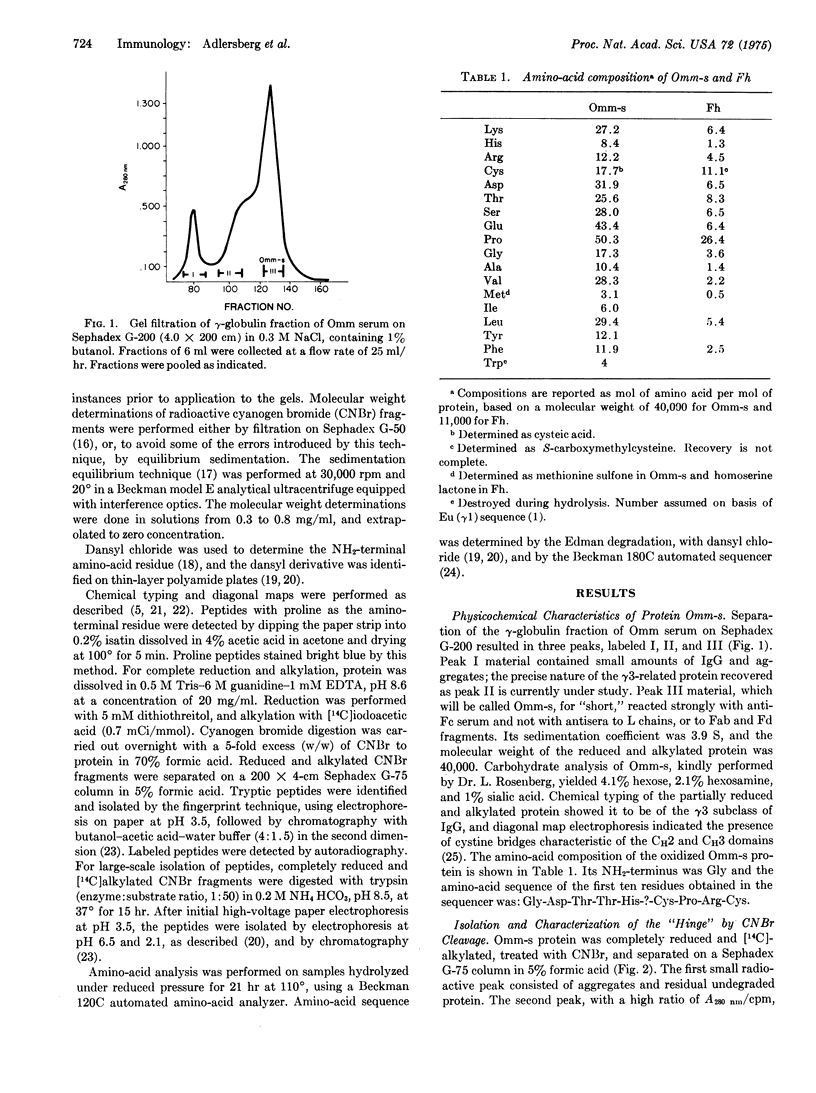
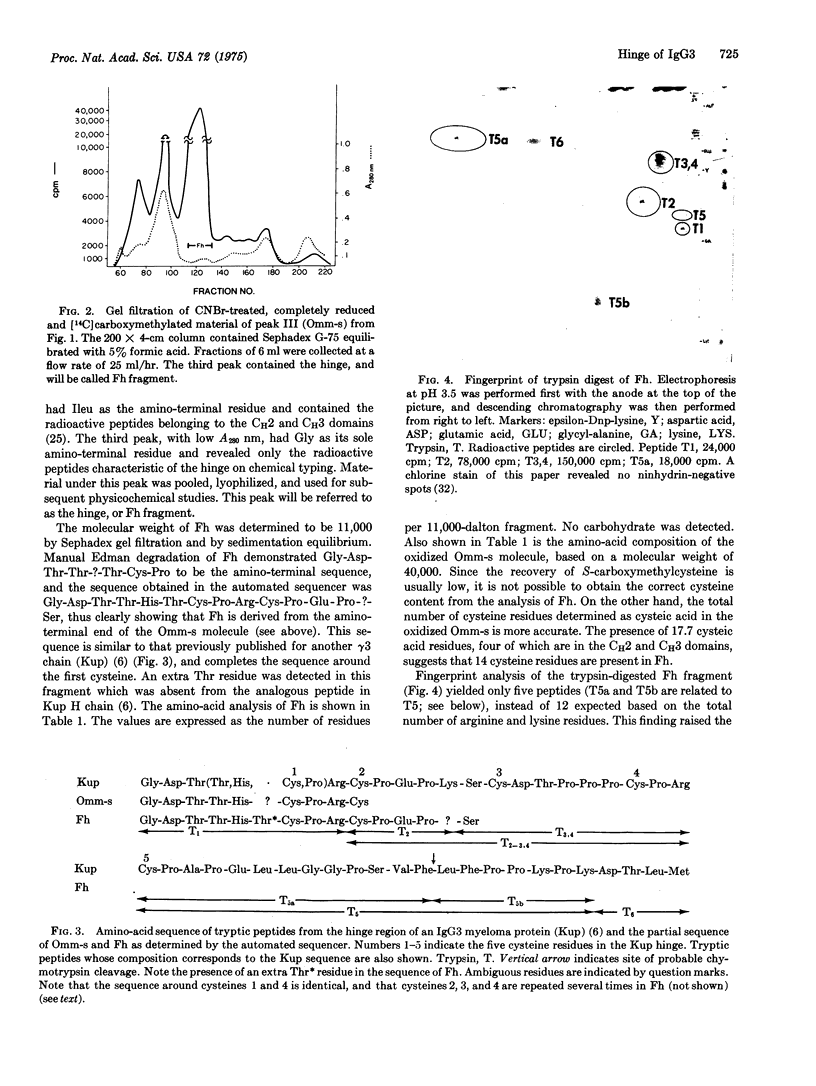
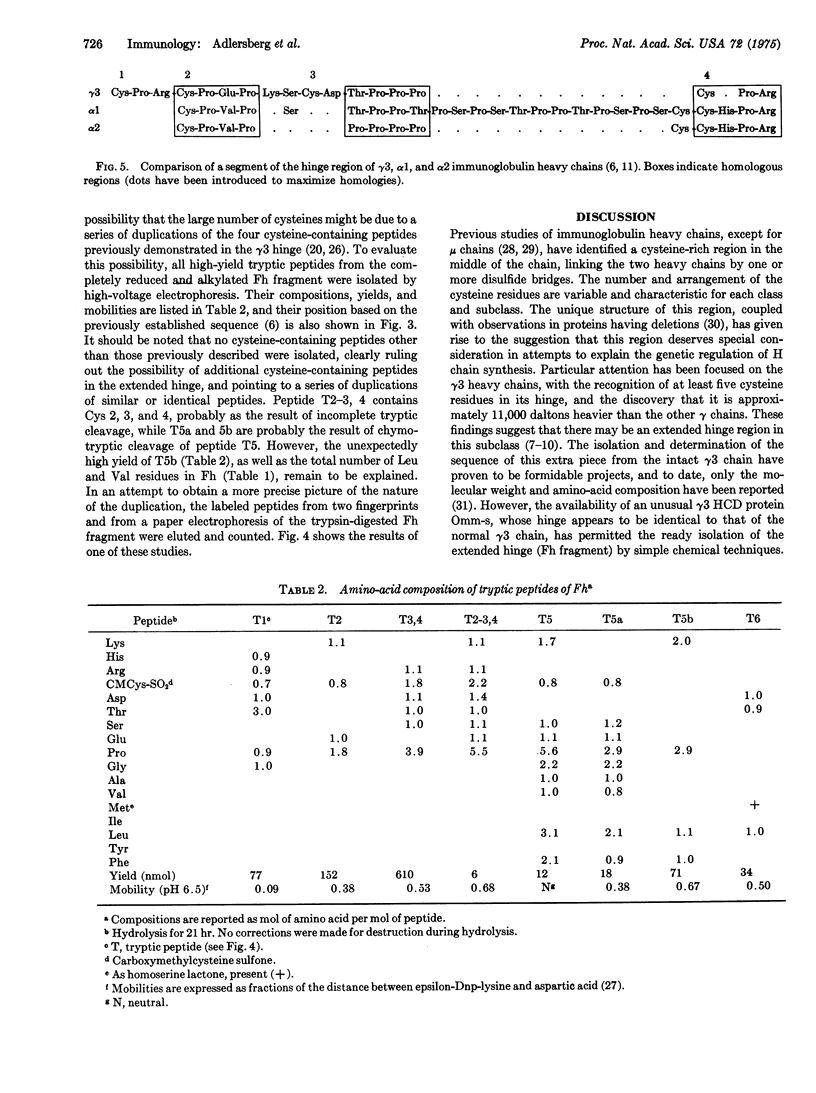
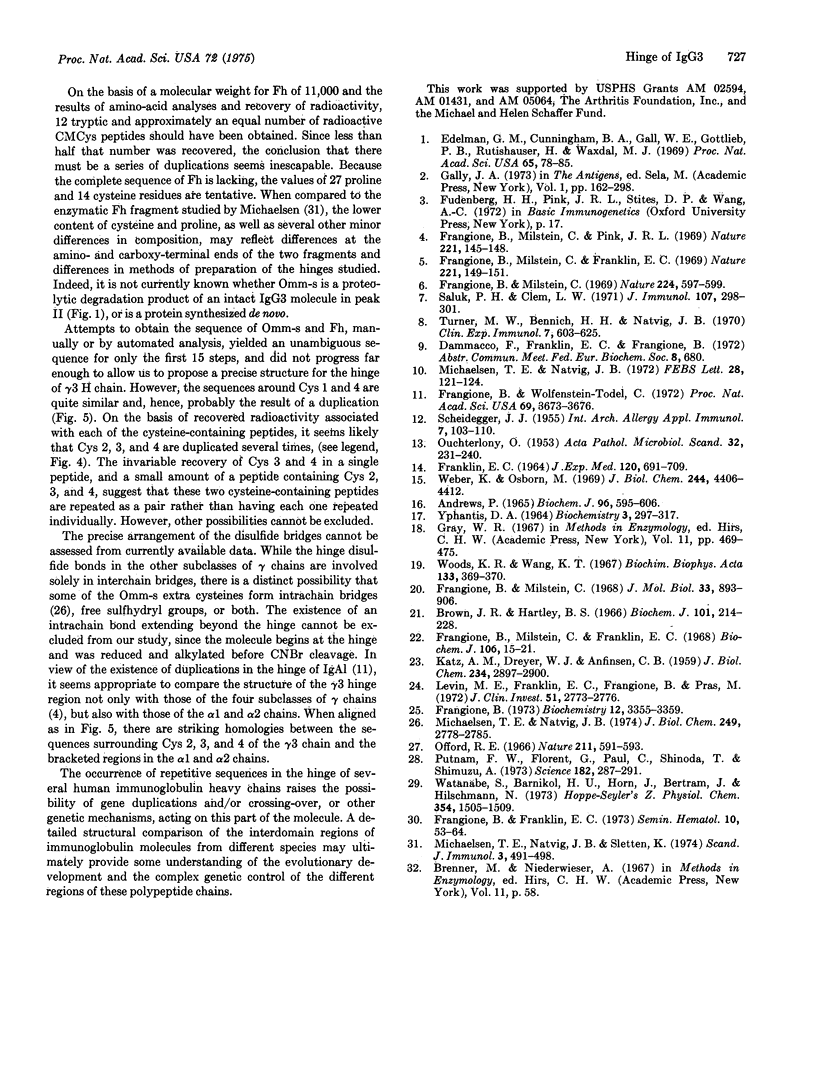
Images in this article
Selected References
These references are in PubMed. This may not be the complete list of references from this article.
- Andrews P. The gel-filtration behaviour of proteins related to their molecular weights over a wide range. Biochem J. 1965 Sep;96(3):595–606. doi: 10.1042/bj0960595. [DOI] [PMC free article] [PubMed] [Google Scholar]
- Brown J. R., Hartley B. S. Location of disulphide bridges by diagonal paper electrophoresis. The disulphide bridges of bovine chymotrypsinogen A. Biochem J. 1966 Oct;101(1):214–228. doi: 10.1042/bj1010214. [DOI] [PMC free article] [PubMed] [Google Scholar]
- Edelman G. M., Cunningham B. A., Gall W. E., Gottlieb P. D., Rutishauser U., Waxdal M. J. The covalent structure of an entire gammaG immunoglobulin molecule. Proc Natl Acad Sci U S A. 1969 May;63(1):78–85. doi: 10.1073/pnas.63.1.78. [DOI] [PMC free article] [PubMed] [Google Scholar]
- FRANKLIN E. C. STRUCTURAL STUDIES OF HUMAN 7S GAMMA-GLOBULIN (G IMMUNOGLOBULIN). FURTHER OBSERVATIONS OF A NATURALLY OCCURRING PROTEIN RELATED TO THE CRYSTALLIZABLE (FAST) FRAGMENT. J Exp Med. 1964 Nov 1;120:691–709. doi: 10.1084/jem.120.5.691. [DOI] [PMC free article] [PubMed] [Google Scholar]
- Frangione B. A technique for the detection of deleted immunoglobulin heavy chains. Biochemistry. 1973 Aug 14;12(17):3355–3359. doi: 10.1021/bi00741a033. [DOI] [PubMed] [Google Scholar]
- Frangione B., Franklin E. C. Heavy chain diseases: clinical features and molecular significance of the disordered immunoglobulin structure. Semin Hematol. 1973 Jan;10(1):53–64. [PubMed] [Google Scholar]
- Frangione B., Milstein C., Franklin E. C. Chemical typing of immunoglobulins. Nature. 1969 Jan 11;221(5176):149–151. doi: 10.1038/221149a0. [DOI] [PubMed] [Google Scholar]
- Frangione B., Milstein C., Franklin E. C. Intrachain disulphide bridges in immunoglobulin G heavy chains. The Fc fragment. Biochem J. 1968 Jan;106(1):15–21. doi: 10.1042/bj1060015. [DOI] [PMC free article] [PubMed] [Google Scholar]
- Frangione B., Milstein C. Partial deletion in the heavy chain disease protein ZUC. Nature. 1969 Nov 8;224(5219):597–599. doi: 10.1038/224597a0. [DOI] [PubMed] [Google Scholar]
- Frangione B., Milstein C., Pink J. R. Structural studies of immunoglobulin G. Nature. 1969 Jan 11;221(5176):145–148. doi: 10.1038/221145a0. [DOI] [PubMed] [Google Scholar]
- Frangione B., Milstein C. Variations in the S-S bridges of immunoglobins G: interchain disulfide bridges of gamma G3 myeloma proteins. J Mol Biol. 1968 May 14;33(3):893–906. doi: 10.1016/0022-2836(68)90326-4. [DOI] [PubMed] [Google Scholar]
- Frangione B., Wolfenstein-Todel C. Partial duplication in the "hinge" region of IgA 1 myeloma proteins. Proc Natl Acad Sci U S A. 1972 Dec;69(12):3673–3676. doi: 10.1073/pnas.69.12.3673. [DOI] [PMC free article] [PubMed] [Google Scholar]
- KATZ A. M., DREYER W. J., ANFINSEN C. B. Peptide separation by two-dimensional chromatography and electrophoresis. J Biol Chem. 1959 Nov;234:2897–2900. [PubMed] [Google Scholar]
- Levin M., Franklin E. C., Frangione B., Pras M. The amino acid sequence of a major nonimmunoglobulin component of some amyloid fibrils. J Clin Invest. 1972 Oct;51(10):2773–2776. doi: 10.1172/JCI107098. [DOI] [PMC free article] [PubMed] [Google Scholar]
- Michaelsen T. E., Natvig J. B., Sletten K. Isolation of a fragment, Fh, corresponding to the hinge region of human IgG3. Scand J Immunol. 1974;3(4):491–498. doi: 10.1111/j.1365-3083.1974.tb01282.x. [DOI] [PubMed] [Google Scholar]
- Michaelsen T. E., Natvig J. B. The hinge region of IgG3, an extended part of the molecule. FEBS Lett. 1972 Nov 15;28(1):121–124. doi: 10.1016/0014-5793(72)80691-4. [DOI] [PubMed] [Google Scholar]
- Michaelsen T. E., Natvig J. B. Unusual molecular properties of human IgG3 proteins due to an extended hinge region. J Biol Chem. 1974 May 10;249(9):2778–2785. [PubMed] [Google Scholar]
- OUCHTERLONY O. Antigen-antibody reactions in gels. IV. Types of reactions in coordinated systems of diffusion. Acta Pathol Microbiol Scand. 1953;32(2):230–240. [PubMed] [Google Scholar]
- Offord R. E. Electrophoretic mobilities of peptides on paper and their use in the determination of amide groups. Nature. 1966 Aug 6;211(5049):591–593. doi: 10.1038/211591a0. [DOI] [PubMed] [Google Scholar]
- SCHEIDEGGER J. J. Une micro-méthode de l'immuno-electrophorèse. Int Arch Allergy Appl Immunol. 1955;7(2):103–110. [PubMed] [Google Scholar]
- Saluk P. H., Clem L. W. The unique molecular weight of the heavy chain from human IgG3. J Immunol. 1971 Jul;107(1):298–301. [PubMed] [Google Scholar]
- Turner M. W., Bennich H. H., Natvig J. B. Pepsin digestion of human G-myeloma proteins of different subclasses. I. The characteristic features of pepsin cleavage as a function of time. Clin Exp Immunol. 1970 Nov;7(5):603–625. [PMC free article] [PubMed] [Google Scholar]
- Watanabe S., Barnikol H. U., Horn J., Bertram J., Hilschmann N. Die Primärstruktur eines monoklonalen IgM-Immunoglobulins (Makroglobulin Gal.), II. Die Aminosäuresequenz der H-Kette (mu-Typ,Subgruppe HIII), Struktur des gesamten IgM-Moleküls. Hoppe Seylers Z Physiol Chem. 1973 Oct-Nov;354(10-11):1505–1509. [PubMed] [Google Scholar]
- Weber K., Osborn M. The reliability of molecular weight determinations by dodecyl sulfate-polyacrylamide gel electrophoresis. J Biol Chem. 1969 Aug 25;244(16):4406–4412. [PubMed] [Google Scholar]
- Woods K. R., Wang K. T. Separation of dansyl-amino acids by polyamide layer chromatography. Biochim Biophys Acta. 1967 Feb 21;133(2):369–370. doi: 10.1016/0005-2795(67)90078-5. [DOI] [PubMed] [Google Scholar]
- YPHANTIS D. A. EQUILIBRIUM ULTRACENTRIFUGATION OF DILUTE SOLUTIONS. Biochemistry. 1964 Mar;3:297–317. doi: 10.1021/bi00891a003. [DOI] [PubMed] [Google Scholar]



